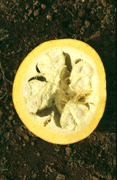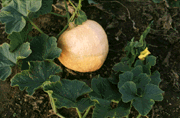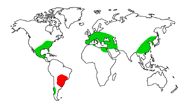Pumpkin (Cucurbita maxima)
Marrow family
(Cucurbitaceae)

| 
|
| Cut fruit | Pumpkin plant
|
Source: Bock D., MPI Kűöln
Distribution, Yield, Use:
- Distribution:
Grown world-wide in the tropical to the temperate
zones.
Requires rich, warm soil.
- Yield:
50-250 kg fruit/plant
- Use:
boiled as vegetable, compot
The fruit contains
90-93% water, 6% carbohydrate,
1% protein, 0.1% fat.

Region of origin:  Region of cultivation:
Region of cultivation: 
- Cultivation and Breeding:
The pumpkin arose from the wild pumpkin Cucurbita andreana which occurs on the plains of Argentina. This wild pumpkin is very resistant to drought and forms a large number of dark green, hard-skinned fruits (5-7 cm dia.) which have a bitter taste and contain numerous seeds. The indigenous peoples of the South American steppes laid the foundations for cultivation with the discovery of mutants lacking the bitter taste.
The pumpkin had already spread from central America to the south of South America before the time of Columbus. Modern cultivated forms are distinguished by large fruits, in excess of 25 kg, with soft rind and a high amount of flesh without bitterness.
- Breeding aims:
High yield, fruit flesh quality, stability of the fruit and early ripening are important breeding aims.
Text by
Dr. Wolfgang Schuchert
Adapted to HTML by R.Saedler



 Region of cultivation:
Region of cultivation: 